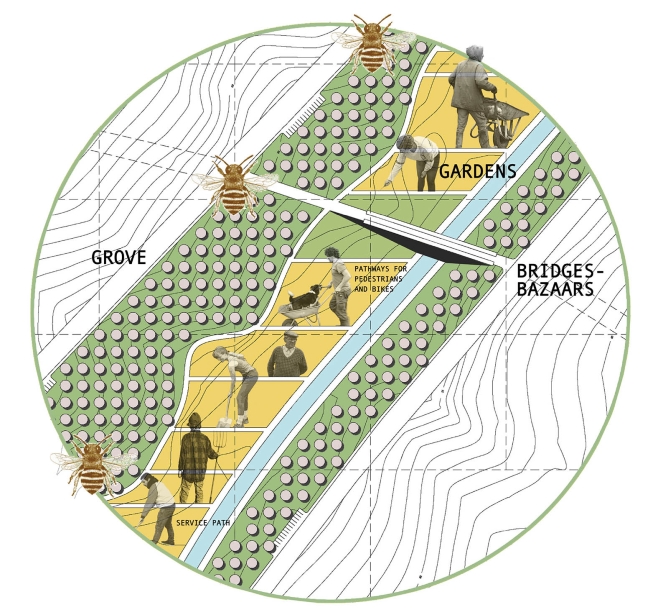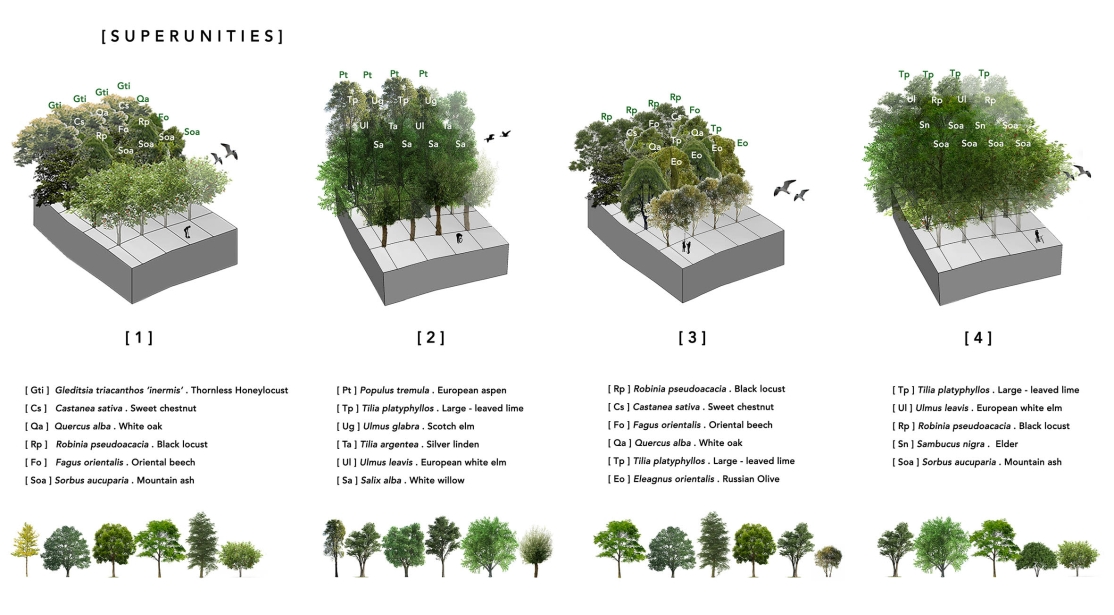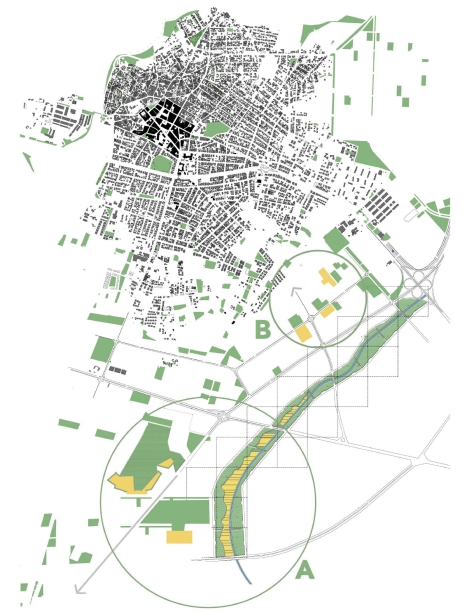A Ğ A Ç L A R , B O S T A N L A R , K Ö P R Ü L E R , K O V A N L A R :
B İ R Y E R Y Ü Z Ü M O D Ü L Ü
T R E E S , G A R D E N S , B R I D G E S , H I V E S :
A N E A R T H M O D U L E
1ST PRIZE EQUIVALENT / EŞDEĞER 1.ÖDÜL + EURAU 2018 SÜRDÜRÜLEBİLİR ÇOK İŞLEVLİ PEYZAJLAR KATEGORİSİ + IFLA 2019 SÜRDÜRÜLEBİLİR KENT DÖNÜŞÜMÜ KATEGORİLERİ
+ EURAU 2018 Conference Scientific Committee Acceptance 'Sustainable Urban Transformation Category from 600 entry', Alicante SPAIN
+ IFLA 2019 World Congress Common Ground Scientific Committee Acceptance 'Sustainable Multifunctional Landscapes Category', Oslo NORWAY
+ Keywords: Tosbağa Dere City Park & Recreation + Forestry + Apiculture + Rewilding + Ecological Restoration + Reference Ecosystem + Permaculture + Edible Gardens + Bazaars + Social & Economical Model
+ Tosbağa Dere Lüleburgaz, Kırklareli TR + 75 ha
+ 2018 + Completed Project + Please swipe left for images.
+ Owner Lüleburgaz Belediyesi Lüleburgaz Municipality
+ Collaboration + Hakan Tüzün Şengün PARCH
+ Acceptance + IFLA 2019 World Congress Scientific Committee Oslo NORWAY + EURAU 2018 Conference Scientific Committee Alicante SPAIN

Humans, like all other organisms on the world, are part of nature. Urban rhetoric versus rural life in contrast to urban life makes us think about the balance, which is the most critical necessity of today's world. The implementation of a fiction that falls within the vital responsibilities of persons as they can enter nature will mobilize the ecological impulses that enable an earth for the vital recipe and sustain the necessary natural balance. Depending on the climate, topography, water regime and soil characteristics, the areas of influence of the plants as separate and communities will be clarified and the relation of the animals to the knowledge of plant communities directly or indirectly in terrestrial or aquatic environment will be described. 'Trees, Gardens, Bridges, Hives’ is a module for Luleburgaz City at Thrace-Ergene basin of Turkey and the module has projected ecologically and architecturally on Tosbaga Creek which is at southeast of the city. As a module for the earth, a habitat constructed by the local knowledge of the specific city that contributes to the earth will spontaneously and naturally emerge with basic architectural knowledge. The project is an idea of both architectural and ecological module for cities. It is located on the border between nature and rural countryside of Luleburgaz City which can be the first city for the earth module.
Landscape, Landscape Architecture, Architecture, Agriculture, Sustainability, Urban Design, Ecological Infrastructure Restoration
'Trees, Gardens, Bridges, Hives’ as a remote module within the reachable distance from the Luleburgaz City, comes from an architectural plan that builds up the structure with a low budget of natural, local materials and workmanship. In this projecting, addressed with reference to the prevailing order of nature, provides us with the uses that can turn the urban contact into routine. The horizons of nature can not be interrupted, topography, soil and atmosphere are the most important figures. Birds, bees, butterflies and people will help this newborn cycle. Animals are ecosystem regulators; dusting the flowers, scattering the seeds, fertilizing the land and fertilizing the plants, planting the harmful plants. Thus, a biodiversity will increase in this earth's modulus, and a balanced and disease-free natural system will develop over time. According to the view that ecological system aims to restore conventional landscaping and natural cycles that agriculture has destroyed, native plant horticulture and the spread of landscapes mimicking natural plant groupings will not be able to compensate for the loss of native species and habitat even if urban horticulture and parks are filled with indigenous plants. 'Trees, Gardens, Bridges, Hives’ is an idea of both architectural and ecological module for cities. It is located on the border between nature and rural countryside of Luleburgaz City which can be the first city for the earth module. Routine meteorological events and rapid atmospheric contaminants, which lead to toxic linear air pollution from the city, pass through a rural buffer, which is defined as the development area of the city before reaching the interiors of the module which is also a terrestrial, reaching the grove which is an enormous shield of the module and a filtration task.
THE GROVE MADE OF SUPERUNITIES
Trees reduce radiant heat loss, which prevents air mixing, and creates a large number of microclimate that do not escape the winds by giving shadows. For food and water, they can reach very high depths of soil for solar energy. It is constructed by planting 2288 pieces of trees, which are fast growing and drought resistant 14 different species, on the axis of a gridal arrangement, which can be grown with 30 cm or more rainfall per year in the forest of the earth. Tosbağa Creek is located on the slopes of the bedrock, and the order of the habitat described by the grove ecological system comes from the tree communities forming the lower units. These tree communities, defined as repetitive and superunities, are the coexistence of specific species with qualities that can constitute the basic equilibrium. Such a regiment, the grove, is more than two dimensions that have no ecological connections, isolated and sampled high-tall trees and only some of the ground coverers, and instead, thanks to the trees and foliage planted in various sizes, the sounds of birds coming from the birds can be heard, wildlife will describe a life that fills. Tree associations are unique to the place they are and a plant community that works well in one region may not be suitable for a different region. It is straightforward to determine the species in accordance with the experience acquired according to local references and by observing their compliance. For this reason, the types of superunities suggested for the grove and the system-dependent ground cover and vine layer consist of species suitable for the Iranian-Turanian floristic elements in the Thrace-Ergene basin. Thanks to the superunities, the trees produce habitats as partners that can be integrated with each other, not as individually selected samples. The slope soil of Tosbaga Creek will be kept by the trees of the grove, and the need for rubbing the soil causing erosion will be removed.
GARDENS FOR PRODUCTION
Gardens work together with the bazaars established on the pedestrian bridges. The bridges whose boundaries are determined by the idea of the earth's module, participate in everyday life by determining the zones within themselves according to the personal initiative of the inhabitants of the city. The products obtained can be offered for sale in the bridge bazaars as well as to meet the daily nutritional needs of the city. Thanks to the crops to be marketed, the gardens are ideally able to provide habitats from birds fed from the soil to birds fed insects to worms and rabbits to chickens. They have the possibility to organize the crops they can buy by identifying the urban areas and they will be able to receive the necessary consultancy within the framework of the program included in the idea of the earth's module.
BRIDGES AS BAZAARS
The continuity of the grove in the two wings of Tosbaga is protected by the establishment of a running and cycling track which is in two directions of the creek bed and it is foreseen to be connected to the five points by pedestrian bridges. These bridges are also used as a social interaction and activity area, a shopping mall that keeps the regional economy of the region alive as bridges - bazaars that are used as temporary or permanent market places. In addition to all kinds of private and local agricultural products produced in the region, systematically placed hives and earth’s module will also function as an important beekeeping center. The bridges - the bazaars will be enriched by the vistas of the garden and grove activity on the creek bed, and will function as a social and cultural living space to be alive throughout the day. When the recreational function takes place, the first-hand actors of local production and the urban people can be brought together thanks to the bridging markets. Thus, as an earth module, the area with a sub-internal cycle itself will be able to live as a local microeconomic area and enable the local values to be kept alive in a sustainable context.
HIVES AND PLANTING FOR BEES ON THE GROVE BASEMENT FOR BEES
The plants can not move, so external factors are necessary to help them to become pollinated so that they can reproduce. A large part of the flowering plants are cross-pollinated with highly complex pollinators such as flies, moths, butterflies, birds and wounds, which are less important than bees and bees. In the polynomial that occurs with external match, genetic diversity is increased, harmful genes are prevented from recurring, plants become resistant. The bees and the flowers differed formally in harmony with each other in their physical properties. The flowers provided by the pollination bees should usually be of blue, purple, lavender or white color. For this reason, the selected ground cover layer for the grove is made up of flowering species that are liked by the bees. The bears will come to the flowering plant species on their own in the earth's modulus in natural life; but the hives that will still be found by the colonists will be placed in the tree-shaded areas in the grove area. The hives must be positioned simply so that the grove remains between the plants to be pollinated. The earth will be able to share the products of the colonies and hives that will be able to change places for increase of pollination and efficiency in the module, as well as to develop products on the pedestrian bridges as well as to improve the lives of the gardeners. Personal initiatives to increase and protect biodiversity by contributing to pollination of crops in order to protect ecological cycle and habitat will be able to observe the life of bee colonies and study the productivity of plants and bees using the six areas of protection. The location of the hives can be changed according to which bee colon is desired to pollinate which plants.


